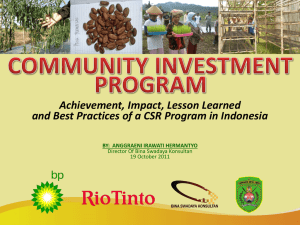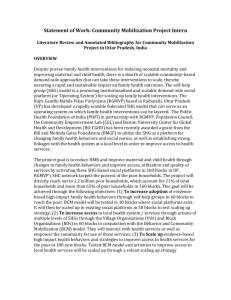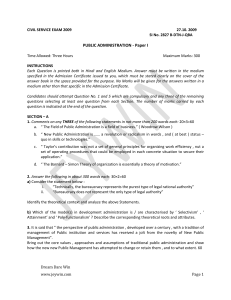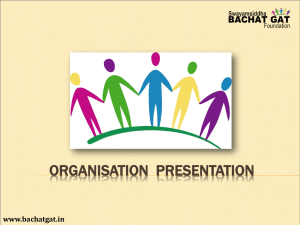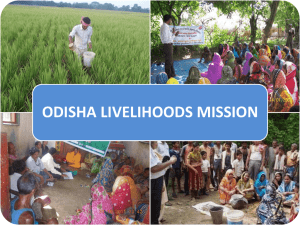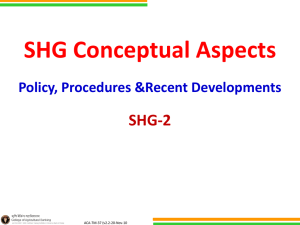empowering the poor
advertisement
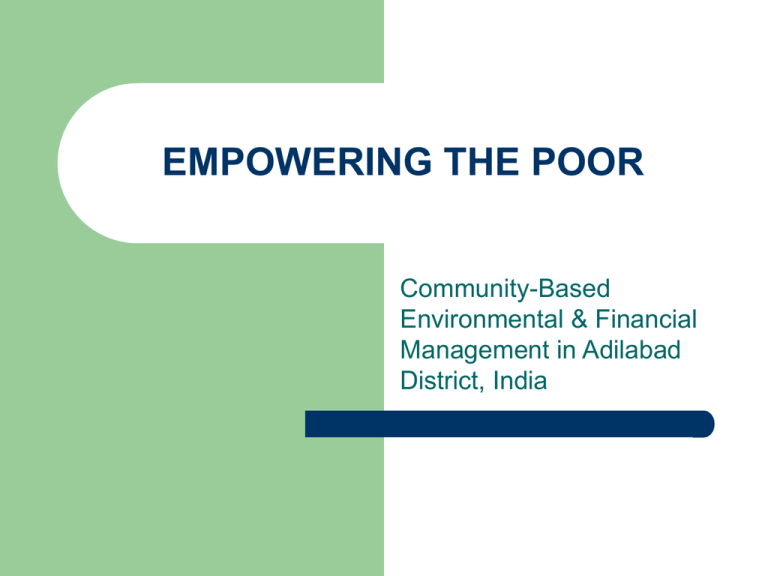
EMPOWERING THE POOR Community-Based Environmental & Financial Management in Adilabad District, India CFI Project Goals MAJOR GOALS Identify rural development investments strategies that have a sustainable impact on target populations & environments Minimize transaction costs to maximize effectiveness of development investments Secure rights over assets for the beneficiary group Empower tribal women Identify Incentives and projects that support community-based natural resource management cont. CFI Project Goals OPERATIONAL GOALS Assess how Self Help Groups (SHGs) and SHG federations can sustain and expand benefits from IFAD project investments Explore how community-based watershed restoration projects can provide environmental service payments for the rural poor Evaluate the potential of SHGs to receive and manage environmental service payment contracts Examine how environmental service payments are being utilized and reinvested Challenges in Adilabad Heavy tribal dependence on natural resources High poverty area High levels of illiteracy (up to 85% among tribals) Growing land and resource pressure from migrants Increasing tribal landlessness Lack of rights to forest resources Rampant illegal logging Degradation of upland watersheds The Gond Tribals of Adilabad Program Timeline 1994: IFAD begins support to Andhra Pradesh Participatory Tribal Development Project through Integrated Tribal Development Authority (ITDA) $25 million budget for natural resource restoration and development, small-scale irrigation, reforestation, and soil & water conservation - $12 million for small scale credit & community institutions building (SHGs) 1995-2000: 500 SHGS formed in Adilabad District 2000: IFAD begins contracting with SHG for small projects 2001: World Bank funds DPIP creating Velegu and SHG Federations 2003: IFAD-APPTDP ends Participatory Research Design PARTICIPATORY RESEARCH METHODS In-depth Interviews -IFAD -Integrated Tribal Development Agency (ITDA) -Dhan Foundation -Velegu -SHG leadership & members -Community members cont. Participatory Research Methods Group discussions with SHGs Process documentation of SHG federation meetings Spatial analysis of the increase in SHGs and cluster patterns cont. Participatory Research Methods Research Sites -2.5 million people -High proportion of tribal people (Gond, Lambada, and Kolam) -Heavy dependence on forests -Critical watersheds cont. Participatory Research Methods Case Study Sites -SHG formation in Pittabangaram Village -SHG clusters in the Movad Valley -SHG federation of Kerimeri Sub-district -SHG federation in Indravelli Sub-district Study Areas in Adilabad District cont. Participatory Research Methods Research Process Jun - Aug 2002 Research Design Sep 2002 – Aug 2003 Data Collection May – Dec 2003 Analysis & Report Development Oct 2003 – Jan 2004 Film Production Institution Building Process SHG FORMATION (6-12 months) (catalyzed by ITDA, Velegu, and the Dhan Foundation) -8 to 18 women form an SHG -Develop a common vision & identity leaders -Start a savings account & begin contributing -Develop basic accounting system -Undertake project & market activities cont. Institution Building Process SHG CLUSTER DEVELOPMENT (12-24 months) -Meeting of SHGs (2-12) within walking distance -Form an SHG Cluster Executive Committee -Register as cooperative society -Open a joint bank account -Participate in training program -Bid on joint projects cont. Institution Building Process SHG FEDERATION DEVELOPMENT (24-56 months) - - Velegu and Dhan hold meetings of SHG and SHG clusters in Kerimeri and Indravelli Sub-districts in June 2001 Sub-District SHG federations have 100 to 120 SHGs Election of office bearers and federation accounts opened Member SHGs pay monthly dues for federation activities Federations are registered under the Indian Trust Act of 1882 Cont. Institution Building Process -Federations functions: -Provide training support to SHGs -Represent SHGs with local government, rural banks, line agencies and other organizations -Address social issues (e.g. mass weddings, etc.) -Resolve conflicts Indravelli SHGs, Clusters, & Federations Kerimeri SHGs, Clusters, & Federation Economic Strategies JUSTIFICATION FOR WATERSHED MANAGEMENT PROJECTS Reversing watershed deterioration is a high priority in India Over 50% of India’s land area is classified as degraded watershed Problems include loss of vegetation cover, soil erosion, declining groundwater levels, decreasing crop productivity, and out-migration Watershed investment in the mid-1990s was over $500 million Average cost per IFAD village watershed is $4,300 over five years Fast returns in terms of high crop yields from improved water capture and higher soil moisture levels can recover costs within 4 years cont. Economic Strategies IMPACT OF CONTRACTING WATERSHED RESTORATION THROUGH SHGS Improved design and location of structures Greater sense of ownership and improved maintenance Better use of improved resources (e.g. seasonal ponds, woodlots, etc.) Reduced “leakage” of small project funds Improved employee payment 30% contractor’s commission added to SHG savings Community Banking & Micro-Finance Rural indebtedness a major cause of poverty Rural moneylenders charge 5% per month and more for loans Chronic indebtedness leads to loss of agricultural land, especially among tribals Lack of access to capital constrains small enterprise initiatives cont. Community Banking & MicroFinance IMPACT OF SHG SAVINGS PROGRAMS 19,500 SHGs involving 200,000 women in Adilabad District have saved an average of $27 SHG members have not only learned to save, but have learned to reinvest Adilabad SHGs have a default rate of less than 4% with rural banks vs 33% for all borrowers With good credit ratings, some SHGs have been able to leverage their savings with a 4:1 debt to savings ratio Dependency on moneylenders is decreasing rapidly while land security is enhanced Co-operative Marketing Tribal farmers get low prices for agricultural produce due to: Use of future harvest as collateral for agricultural input loans from moneylenders Lack of storage facilities Absence of agro-processing facilities High transaction costs (i.e. up to 9 layers of traders between the farmer & consumer cont. Co-operative Marketing SHGs and SHG clusters are using savings to: Buy soybeans and Lac harvests Establish soybean oil processing facility Intensify Lac production Purchase agricultural inputs at wholesale rates cont. Co-operative Marketing Impact of SHG cooperative marketing initiatives: Farmer’s soybean income increases 7-8% Farmer is paid 100% at the time of sale Processing adds 20% to soybean value Lac prices increase 3-5 fold Project Impact 500 SHGs formed in 300 villages, Adilabad District Of the $3.2 million spent on small projects in Adilabad, $638,000 was for SHG contracts SHGs saved $40,400 from contracts in Indravelli sub-district and leveraged an additional $76,600 through bank loans SHGs saved $31,967 from environmental service contracts in Kerimeri sub-district creating a dramatic increase in SHG savings accounts SHG capital is used for loans for agricultural inputs, rapidly displacing dependence on moneylenders Reduced reliance on moneylenders is slowing the rate of tribal land sales and landlessness Risks & Recommendations CRITICAL RISKS RECOMMENDATIONS Unsustained political & financial commitment to Velegu More SHG representatives on Velegu executive committee Poor inter-agency & program coordination ITDA continues to play coordinating role. Integration of village-level microplan. Target orientation can rush development of SHGs Allow time for capacity building External funders of SHGs may drive their decision making Strengthen SHG capacity for reviewing proposed action plans Limited financial management capacity of SHGs Develop simple accounting procedures for SHGs. Poor linkages of SHGs with banks Facilitate SHG relationships with rural banks Corruption among local government administrators & bookkeepers SHG federations should refer complaints to Velegu’s governing board. SHGs hire bookkeepers. Constraints to Environmental Service Payments to Rural Poor High transaction costs of emerging international carbon-offset and biodiversity conservation payment systems Lack of commitment to fund by the private sector Lack of a channel or mechanism to transfer funds to communities Absence of community capacity to receive and manage payments Lack of “community-owned” institutions to contract with external organizations Advantages of SHG Approach SHGs enhance community capacity to receive and manage funds from environmental service payments Contracting directly through SHGs Clusters and Federations dramatically reduces transactions costs for ESP contracts ESP project contracts empower communities as resource managers and create incentives for sustainable management ESP projects encourage further investment in resource restoration and development Recommendations for IFAD Promote ESP strategies & goals through IFAD’s community institution building, livelihoods, and natural resource projects Emphasize direct contracting small projects through community-based institutions Coordinate with bi-lateral and multi-lateral projects to ensure continuity of strategy and support Build an ESP alliance with major development agencies to facilitate ESP investment by governments and the private sector THE END

